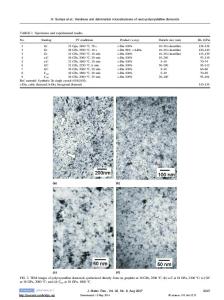Transport Properties of Polycrystalline Silicon with Various Textures and Microstructures
- PDF / 161,479 Bytes
- 6 Pages / 612 x 792 pts (letter) Page_size
- 39 Downloads / 323 Views
Transport Properties of Polycrystalline Silicon with Various Textures and Microstructures Toshio Kamiya, Kouichi Nakahata, Atsushi Suemasu, Kazuyoshi Ro, C.M. Fortmann and Isamu Shimizu The Graduate School, Tokyo Institute of Technology, 4259 Nagatsuta, Midori-ku, Yokohama, JAPAN ABSTRACT Carrier transport property was studied in relation to microstructure for polycrystalline silicon (poly-Si) prepared from SiF4 and H2 gas mixtures at temperatures below 360oC. It was found that Hall mobility markedly increased with the increase in crystal fraction especially at crystal fractions larger than 80% and it exhibited good correlation with orientation fluctuation as well as with crystal fraction. In addition, dependence of Hall mobility on orientation fluctuation exhibited different tendency between (220) and (400) oriented poly-Si. It suggests that atomic configuration and electronic structure at grain boundaries depends on orientation structure, resulting in the different dependence of Hall mobility on orientation fluctuation. By applying hot-vapor annealing at 310oC to 1 µm-thick P-doped (400) oriented poly-Si, Hall mobility was improved from 10 cm2/Vs to 17 cm2/Vs. INTRODUCTION Recently, low temperature fabrication of micro- or polycrystalline silicon (µc-/poly-Si:H) thin films have gathered much interest because of their potential applications such as thin film solar cells, thin film transistors for flat panel displays and so on.[1,2] However, mobility of typical µc-Si:H prepared by RF plasma enhanced chemical vapor deposition (RF PECVD) from H2 diluted SiH4 is much lower (
Data Loading...




